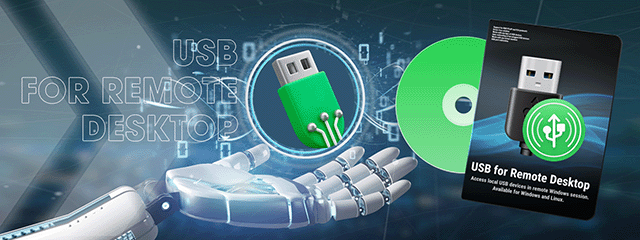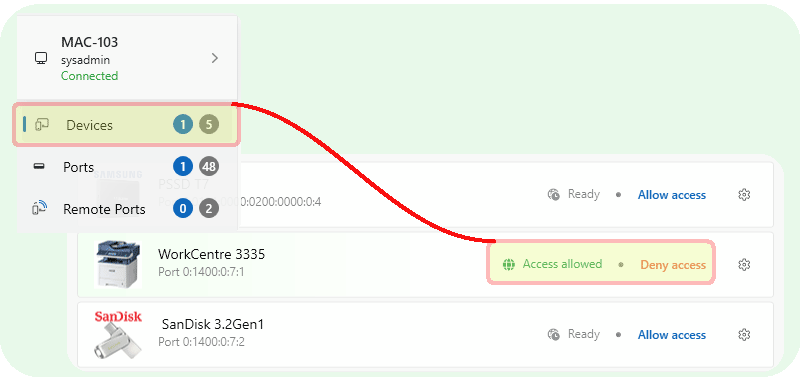
How to Enable USB for Remote Desktop
An abundant choice of remote desktop solutions goes along with a common connectivity problem. While you can easily connect Server and Client machines, the USB redirection in RDP, Citrix, or other software may be a real challenge for you. Unfortunately, the most used devices tend to be inaccessible to Client machines since most remote protocols do not provide adequate support for them.
However, there are specialized apps that enable USB remote desktop passthrough on a universal basis. One such application is USBoNET, which is software designed for smart USB redirection. Learn how it can help you seamlessly share peripherals and protect data exchanges in your virtual environment.
Simple App for RDP USB Passthrough
USBoNET by HighFigure is a multi-functional program the main function of which is enabling USB device passthrough in RDP and similar environments. Thanks to it, you can redirect any peripherals even if your chosen remote desktop solution does not provide support for them.
Based on port virtualization tech, the app creates a remote USB port every time you need to share a local device with guest machines. This software enables its virtual copy. Be it a simple printer or a sophisticated USB microscope, USBoNET will ensure remote access to all functions and tools of such devices.
Devices You Can Redirect in RDP
USBoNET works with all sorts of USB peripherals. Here, an endless list of them could be provided, but let us enumerate the most popular gadgets that you’ll be able to share remotely using the HighFigure app:
- Scanners (including those supporting WIA, ISIS, and TWAIN functionality).
- Printers.
- Webcams.
- Fingerprint readers.
- Smart mice.
- Storage drives, etc.
Does your RDP version have no support for a needed device? Do not worry. The software connects and redirects peripherals even without drivers from the remote desktop supplier.
How USB Passthrough Works in RDP
The most precious feature of the software is its highest level of usability. You won’t need to build an intricate RD configuration to enable USB for remote desktop sessions. In fact, such a configuration will be already at your disposal, and you’ll only have to make two or three clicks to redirect a locally plugged-in device.
USBoNET also provides a set of instruments to smartly manage access rules within your virtual environment. That is, while allowing access to certain groups of users, you can restrict the others in this or that situation. Rules can be changed at any moment, and you can regulate the activities in every RDP session on any device, be it a smartphone, tablet, or whatever.
How to Redirect a USB Device to Remote Desktop
After you have installed the RDP software and plugged the necessary physical gadget into your local computer, you can set up USBoNET and start USB over RDP redirections. Use our step-by-step guide to tune up your sessions with its help:
- Sign up on HighFigure.net or USBoNET.com.
You’ll have to verify your email if you wish to request a 365-day free trial from our team. - Download and install the USBoNET application.
The process is straightforward. The program needs to be set up on both the Server and Client machines. - Run the app.
Use the login info indicated during registration to sign in with the app. As soon as the software is launched, all physically connected peripherals become visible in RDP. - Initiate an RDP session.
You must launch the virtual environment software on your Server computer. Client machines should also do the same. - Open the USBoNET interface and enable the needed device.
The main menu contains a lot of useful tools. However, you need to go to the ‘Device’ section. There, you’ll see all the plugged-in gadgets. Tap the one you need to redirect via the RDP USB passthrough and click ‘Allow Access.’
Now, the peripheral can be used by all authorized remote users. The type of connection plays no role for the program. Wi-Fi, Ethernet, WAN, LAN, or any other networks can be used for smart redirections via the application.
Troubleshooting Problems with RDP Redirection
When using this or that USB gadget on a virtual desktop, you may face issues like an unavailable device or its low-quality performance. How to prevent such situations? Use these universal hints that may mitigate possible inconveniences with your remote USB connection:
- Make sure to connect a physical device according to the installation manual provided by the manufacturer.
- Employ an upgraded version of RDP with all the required drivers and software components installed and updated.
- If sharing video cameras and other high-traffic gadgets and apps, ensure your network has proper bandwidth and is capable of video and audio transmissionы of that sort.
- USB disks may slow down your virtual session if they are inadequately structured and have system problems. So, you should only use the optimized devices of this kind.
- There might also be inconsistencies on the Server or Client machines themselves. The hardware becomes especially vulnerable if running insecure remote desktop sessions. To minimize such issues, protect your computers with a powerful antivirus, strong security system, biometric encryption to RDP, etc. Use advanced monitoring programs to check the performance of your machines.
These simple rules will help you optimize your RDP USB passthrough sessions. Remember that the more sophisticated and traffic-consuming devices you employ, the more powerful the RDP configuration you need.
USBoNET Advanced Functions
The application is a simple program to redirect peripherals from a local to a remote machine. However, that’s not all. USBoNET provides a variety of extra features designed to enhance the performance of your RDP sessions. Their list looks like this:
- Expect secure redirects via USBoNET, which are ensured by a top-advanced method of data encryption.
- The application employs its own server. So, remote machines that have problems with server detection can still access the shared devices within the virtual network.
- USBoNET is a cross-platform solution that can be used on Linux and Windows operating systems. Android and MacOS versions are soon to come out.
- Thanks to premium features like Gate Mode and Web Admin, you can allow access/disallow access to a targeted gadget with a click. You can isolate this or that user and monitor their activities in the virtual environment.
You can download and install the software right now. Its 15-day free trial will be at your disposal. A special offer from HighFigure is 365 days of free access to the full functional set for remote USB redirection. Request a free key from the support service to gain this option.
